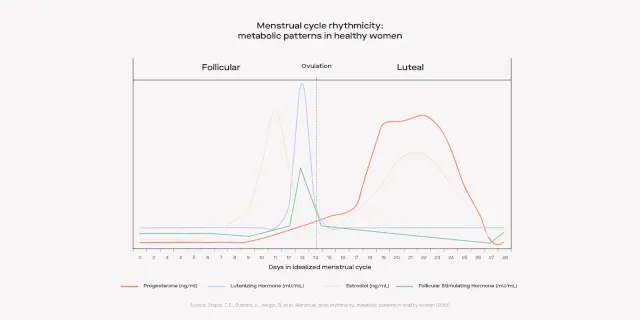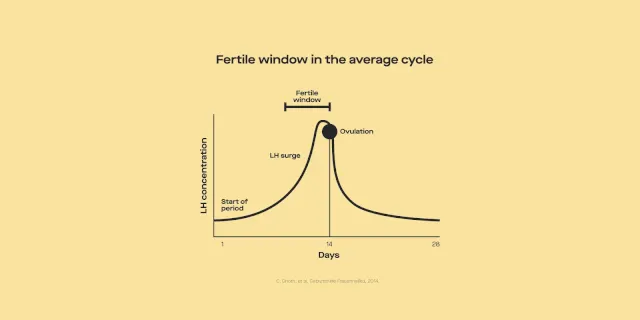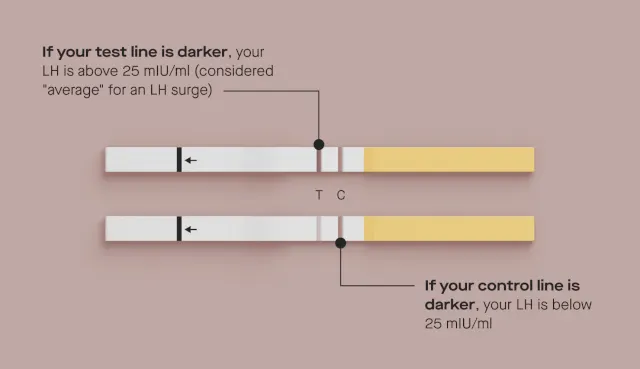Here's what we'll cover
Here's what we'll cover
Ovulation: it's a big part of your overall reproductive health, and, of course, your fertility. When you ovulate and what’s involved might seem like a mystery, but you can demystify the process and figure out when you’re most likely ovulating with the help of the Modern Fertility Ovulation Test strips.
While no ovulation test or ovulation predictor kit can tell you for sure if you’re ovulating, ours is 99% accurate at detecting luteinizing hormone (LH) 1. This is key for understanding when you're in your fertile window and approaching ovulation if you’re trying to conceive — but this info can also be super valuable even if you’re not trying for kids.
Here, we’ll explain what ovulation tests are, what makes ours stand out, and exactly how the Modern Fertility Ovulation Test work.
What are ovulation test strips?
Ovulation test strips, also known as ovulation predictor kits (OPKs) or ovulation predictor tests, work by detecting the presence of luteinizing hormone (LH) in your urine — the hormone that surges around 24-48 hours before ovulation.
Using ovulation tests to help you understand your ovulation patterns can give you the best chances of timing sex or insemination around your fertile window and clue you in to what's going on with your reproductive health.
Ovulation and the menstrual cycle
Ovulation typically comes around day 14 of the "textbook" 28-day menstrual cycle, in between the first and the last phases. Here’s a quick refresher:
Follicular phase: The cycle kicks off with this phase — when follicle-stimulating hormone (FSH) causes the ovarian follicles (which house eggs) to mature and get ready to release an egg. The maturing follicle produces estradiol (a form of estrogen), which sends a signal to the brain to release luteinizing hormone (LH).
Ovulation: Next, a spike in luteinizing hormone (LH) initiates the release of an egg from your ovary into the fallopian tube — making the hormone a great indicator of ovulation. This surge happens 24-48 hours before the egg is released, and it's this surge that's detected by an ovulation test (more on this later).
Luteal phase: After ovulation is the luteal phase. The follicle that released that egg becomes the corpus luteum, which produces progesterone, a hormone that supports fetal growth.

Once you’re ovulating, things (and by "things," we mean "sperm") need to move pretty quickly for conception to happen. Eggs have a brief shelf life, just 12-24 hours, but sperm can last up to five days (!) in the reproductive tract. While this timeline means that the five days before and the day of ovulation encompass what's called the "fertile window," knowing when your LH is surging gives you a pretty good indication that ovulation is right around the corner — making it even more likely that sperm will meet up with egg at the right time.
Why track your ovulation with the Modern Fertility Ovulation Test?
Wherever you are in your fertility journey — or even if you don’t plan to get pregnant any time soon (or ever) — tracking your ovulation can teach you lots of important things about your reproductive health.
If you're trying to get pregnant, the Modern Fertility Ovulation Test can give you the hormonal info you need to find your 2 most fertile days and predict ovulation. The way it does that is through measuring the LH in your urine: If your LH is surging, you’re likely about 24-48 hours from ovulation and have the highest chances of getting pregnant.

If you’re not planning to get pregnant, you can also use the Modern Fertility Ovulation Test to simply learn more about your menstrual cycle — and we’re in full support of getting that kind of knowledge. If you’ve recently stopped taking hormonal birth control, for example, you can use our test kit to reacquaint yourself with your cycle without the influence of synthetic hormones.
How do the Modern Fertility Ovulation Test strips work?
Standard ovulation test kits you find at stores today are mostly threshold-based. In plain-speak, what that means is they give you a negative or positive result when you pee on them.
But everyone has their own LH pattern. In fact, about 1 in 10 of us surge at a level that typically isn’t detected by standard ovulation tests (so you may see a negative result even if you’re approaching ovulation).
We worked closely with our medical advisory board to create a semi-quantitative ovulation test that gives you more nuanced insight into your LH levels when you read the results. Our Ovulation Test strips detect your LH at low, high, or peak levels to help you predict your LH surge — even if you have irregular cycles.
Here’s how our Ovulation Test strips work:
If there's LH in your urine, this test will find it. That LH attaches to LH antibodies in the test and causes a test line to show up right next to the control line — indicating your LH level.
When you take the test, your test line will darken according to the levels of LH in your pee. At a glance, you’ll know if your result is above the average LH surge threshold of 25mIU/ml when the test line is darker than the control line on the strip.
How to read Ovulation Test strips:
Your Ovulation Test result matches to low, high, or peak levels on the test pouch to map a unique LH curve — even if you have irregular cycles or surge below the average LH threshold.
Here’s where the magic really starts happening: If you track your LH levels over time (using the log provided with the test), you can get even more in sync with your unique LH pattern. Using the log, you can visualize when you’re hitting your LH surge — and not just go by the average surge level that the majority of people with ovaries experience.
Importantly, you don’t need to have regular cycles to take the test. Since you’re testing based on your unique LH pattern, you can still detect your surge if your cycles are irregular. That said, it’s always a good idea to check in with your doctor if your cycles are irregular — especially if they’re under 21 days, over 36 days, or if you’ve been diagnosed with a condition like polycystic ovary syndrome (PCOS). Talking with your doctor can help you figure out when (or if) you’re ovulating each cycle.
Besides peeing in a designated area (we’re sure that doesn’t need to be said, but it can’t hurt to clarify!), what else do you need to know about taking the test? We've got the details you need.
Before the test
Start testing 19 days before your period begins. To figure out when that is, you’ll need to determine your cycle length and subtract 19 days from that number. (It might take you a whole cycle to count the length, and that’s totally okay.)
Taking the Ovulation Test in the afternoon will give you the best odds of catching that surge (this rec is based on data from over 11,500 Ovulation Test scans in the Modern Fertility App from users who opted in to our research). If testing in the mornings is the best time for you, that's totally okay. It’s important to choose a time when testing is the most consistently doable for you. (And testing twice a day will give you an extra shot at detecting a surge!)
Don't drink a lot of liquids beforehand — it will dilute your urine and may skew the results.
Save the wrapper once you open the test — it has a chart you'll need later.
During the test
Collect your urine by peeing into a cup, and then insert the absorbent end of the strip up until the “MAX” line (but not past it).
Be sure to lay the test down so that it's flat, and read it after 5 minutes. If you wait 10 minutes, the results will be invalid.
Let the strip sit for 5 minutes then match the test line to the color bar to find your LH concentration.

How to read the Ovulation Test strip.
When is the best time to have intercourse after you detect an LH surge?
Your chances of getting pregnant are highest the five days before you ovulate and the day of ovulation. You reach peak fertility on the day before and the day of ovulation, or the day of and the day after your LH surge. Because LH levels surge 24-48 hours before ovulation, detecting your surge while tracking LH signifies that ovulation is likely around the corner.
So, if you're trying to conceive (TTC), having sex or inseminating as soon as you see your LH surging will give you the best odds of sperm meeting up with egg. That said, doctors recommend having intercourse every 1-2 days during your six-day fertile window since sperm can live in the reproductive tract for up to five days.
If you log and track your Ovulation Test results, you'll also see a prediction of your next fertile window and your 2 most fertile days in your calendar view. Check your log on a daily basis to see when you should be tracking LH to pinpoint the days you're most likely to get pregnant.
What can impact your Ovulation Test results?
Too much fluid intake before you test can dilute your urine and result in a lower LH concentration.
A recent miscarriage or pregnancy (including a chemical pregnancy, or pregnancy loss very soon after embryo implantation), breastfeeding/chestfeeding, menopause, or certain health conditions (like PCOS and thyroid disorders) can cause irregular LH levels. Whatever the reason is for irregular LH levels, you can still track them with the Ovulation Test to help you decode your cycle.
Certain medications, like oral contraceptives (aka “the pill”) or fertility drugs (like Clomid or Femara), can affect both your periods and your LH levels.
If you wait 10 minutes to read your result, the shade of the test line will continue to change and the result will be invalid. Remember to check your results after five minutes.
It’s time to modernize reproductive health
Yes, we’re hormone nerds — and we’re proud of it. Our mission is to make personalized fertility information more accessible. In addition to our Ovulation Test, we also offer:
The Modern Fertility Hormone Test, which measures the same fertility hormones that a doctor would test in a fertility clinic (for a fraction of the price) and helps you understand how your fertility is changing over time. Our test gives you insight into the number of eggs you have and can help you identify red-flag issues — like PCOS or thyroid conditions — that could affect your reproductive health down the line.
The Modern Fertility Prenatal Multivitamin, which helps you prep your body now for pregnancy whenever. It's designed to support your body before, during, and after pregnancy with 12 essential, doctor-backed nutrients. It comes in a sustainable monthly subscription with a (beautifully blue!) reusable glass jar — meaning no more forgotten refills or empty plastic bottles.
We believe that understanding your hormones is the key to understanding your fertility and reproductive health. Our at-home tests give you the info you need about your body to get proactive about all things fertility.
Footnotes
99% accurate at detecting the LH concentrations shown on the chart in laboratory studies.
DISCLAIMER
If you have any medical questions or concerns, please talk to your healthcare provider. The articles on Health Guide are underpinned by peer-reviewed research and information drawn from medical societies and governmental agencies. However, they are not a substitute for professional medical advice, diagnosis, or treatment.










